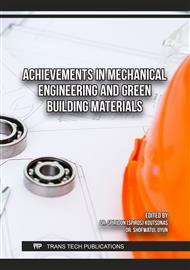[1]
DNVGL. Guideline for the Certification of Offshore Wind Turbines Edition [S]. 2012.6.
Google Scholar
[2]
DNVGL. DNVGL-ST-0361-Machinary for Wind Turbines[S]. 2016.9 .
Google Scholar
[3]
Shengjun Wu,Wei Feng,Feiqi Yuan, A Study on assembly Pre-tensioning Force of Wind Turbine Blade, Journal of Fiber Reinforced Plastics/Composites, Commun. 08(2016) 50-52.
Google Scholar
[4]
Min Gong, Aiqing Ni, Jihui Wang and Zhiwen Qin, Study on the performance of embedded bolt connection of wind turbine blade, Composites Science and Engineering, Commun. 09(2020) 5-10.
Google Scholar
[5]
Ting Yan, Haibo Zhou, Hang Deng, Research on fatigue resistance optimization design of embedded blade root connecting bolts for wind turbine blades, Composite Materials Science and Engineering, Commun. 01(2021) 102-106.
Google Scholar
[6]
Pan Zhuang, Debang Peng, Ling Chen and Jie Liu, Analysis of material selection and heat treatment process for high strength bolts of wind turbine blades, Hot Working Technology, Commun. 48(2019) 175-177.
Google Scholar
[7]
Guang Ma, Yanshuang Yu, Shenglin Liu, Research on Effect of Hot-dip Galvanizing on Fatigue Properties of Q420 Steel for Transmission Tower, Hot Working Technology, Commun. 48(2019) 154-157.
Google Scholar
[8]
ISO 3800 Threaded fasteners-Axial load fatigue testing – Test methods and evaluation of results [S].1993.12.15
DOI: 10.3403/00339945u
Google Scholar
[9]
ISO 12107-2012 Statistical planning and analysis of data[S].2012.08.15.
Google Scholar
[10]
DNVGL-RP-C203 Edition 2016-4 Fatigue design of offshore steel structures[S].2016.
DOI: 10.1115/omae2016-54939
Google Scholar
[11]
Jiabao Chen, Jie Yue, Xianming Zhang, Optimization and quality control of heat treatment process for wind power bolt, Metal Forming, Commun. 01(2024) 82-88.
Google Scholar
[12]
Qin Yan, Quanyu Zhao, Guohua Xia and Ya Liu, ed, Simulation of heat treatment process for 42CrMoA hexagonal bolt, Hunan Nonferrous Metals, Commun. 03(2023) 65-68+82.
Google Scholar
[13]
Yukun Bao, Jinsuo Ma, Meng Wu and Jiacheng Xie, ed, Optimization of heat treatment process for bolt steel resistant to marine atmospheric corrosion, Transactions of Materials and Heat Treatment, Commun. 04(2021) 96-101.
Google Scholar
[14]
Shun Chen, Jianjun Liu, Yue Wu and Jiaqing Wang, ed, The influence of different heat treatment processes on the microstructure and properties of R26 high-temperature alloy bolts, Turbine Technology, Commun. 01(2021) 68-70.
Google Scholar
[15]
Xia Li, Shili Zhu, Manjie Jin, Analysis of cracking causes in heat treatment of 42CrMo high strength bolt, Physics Examination and Testing, Commun. 06(2019) 51-54.
Google Scholar
[16]
Jiang Lin, Analysis of the causes of bolt breakage in wind turbine blades, Modern Manufacturing Technology and Equipment, Commun. 02(2021) 130-131.
Google Scholar
[17]
Zhangbin Yang, Hui Liao, Zongqiu Hu and Wei Zhao,ed, Analysis and treatment of bolt fracture in wind turbine pitch bearing connection, Dongfang Turbine, Commun. 03(2023) 70-72.
Google Scholar
[18]
Chaofeng Peng, Hongliang Wang, Xianzhao Zhang, Failure analysis of high-strength bolt fracture in wind turbine blade connection, Metal Materials and Metallurgy Engineering. 03(2023) 33-36.
Google Scholar
[19]
Mengqi Yang, Wenjun Yang, Jianchao Pang, Chong Gao, ed, Research on fatigue life prediction method for 35CrMo steel bolts, Journal of Central South University. 05 (2023) 1748-1757.
Google Scholar
[20]
Jing Zhang, Yahui Meng, Failure analysis of high-strength bolt fracture in wind turbine blade connection, Metal Materials and Metallurgy Engineering. 06(2022) 21-26.
Google Scholar


